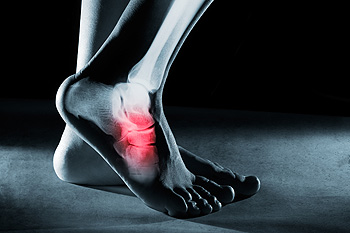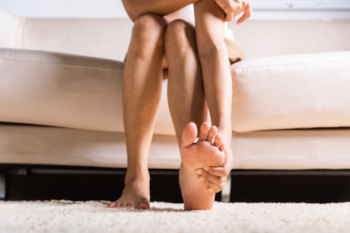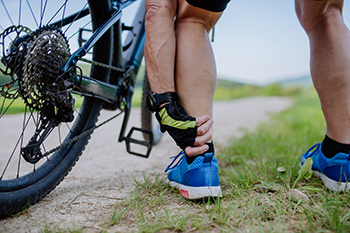Items filtered by date: May 2024
A Rare Genetic Disease and Its Link to Foot Stress Fractures

Hypophosphatasia, or HPP, is a rare genetic disorder characterized by impaired bone mineralization, leading to skeletal abnormalities and increased susceptibility to fractures. While HPP primarily affects bones throughout the body, including the legs and spine, it can also manifest in the feet, causing a range of complications, including stress fractures. In individuals with HPP, the deficiency of alkaline phosphatase enzyme disrupts the normal bone mineralization process, resulting in weakened bones that are prone to fracture under stress or pressure. Foot stress fractures, particularly in the metatarsal bones or heel, can occur due to repetitive impact or weight-bearing activities, exacerbating the existing skeletal fragility associated with HPP. Recognizing the potential connection between HPP and foot stress fractures is critical for an accurate diagnosis and appropriate management strategies. Early intervention, including wearing supportive footwear, orthotic devices, and lifestyle modifications, can help mitigate the risk of fractures and improve the quality of life for individuals living with this rare genetic disease. If you believe you have a foot stress fracture, it is strongly suggested that you consult a podiatrist who can successfully treat these breaks, and determine if HPP is a contributing factor.
Stress fractures occur when there is a tiny crack within a bone. To learn more, contact Dr. Richard T. Bauer from Summit Foot & Ankle. Our doctor can provide the care you need to keep you pain free and on your feet.
How Are They Caused?
Stress fractures are the result of repetitive force being placed on the bone. Since the lower leg and feet often carry most of the body’s weight, stress fractures are likely to occur in these areas. If you rush into a new exercise, you are more likely to develop a stress fracture since you are starting too much, too soon. Pain resulting from stress fractures may go unnoticed at first, however it may start to worsen over time.
Risk Factors
- Gender – They are more commonly found in women compared to men.
- Foot Problems – People with unusual arches in their feet are more likely to develop stress fractures.
- Certain Sports – Dancers, gymnasts, tennis players, runners, and basketball players are more likely to develop stress fractures.
- Lack of Nutrients – A lack of vitamin D and calcium may weaken the bones and make you more prone to stress fractures
- Weak Bones – Osteoporosis can weaken the bones therefore resulting in stress fractures
Stress fractures do not always heal properly, so it is important that you seek help from a podiatrist if you suspect you may have one. Ignoring your stress fracture may cause it to worsen, and you may develop chronic pain as well as additional fractures.
If you have any questions, please feel free to contact our office located in Latham, NY . We offer the newest diagnostic and treatment technologies for all your foot care needs.
Why Live with Pain and Numbness in Your Feet?
How Systemic Diseases Can Affect Feet

There are a host of systemic diseases that can contribute to various foot problems, affecting mobility and quality of life. Sciatica, caused by compression of the sciatic nerve, can lead to radiating pain, numbness, and tingling sensations in the feet. Hypothyroidism, characterized by low thyroid hormone levels, may result in cold feet, swelling, and thickened skin. Embolic arterial occlusion, a sudden blockage of an artery by a traveling clot, can cause acute pain, discoloration, and decreased sensation in the feet. Treatment for these conditions varies, depending on the underlying cause and severity. Sciatica may require pain management or surgery in severe cases. Hypothyroidism typically involves hormone replacement therapy and lifestyle modifications. Treatment for embolic arterial occlusion can include blood thinners, thrombolytic therapy, or surgical intervention. If you are experiencing foot problems associated with a systemic disease, it is suggested that you schedule an appointment with a podiatrist for personalized care and treatment to improve foot function.
When dealing with systemic disease of the feet, it is extremely important to check the affected areas routinely so that any additional problems are caught quickly. If you have any concerns about your feet and ankles contact Dr. Richard T. Bauer from Summit Foot & Ankle. Our doctor will assist you with all of your podiatric needs.
Systemic Diseases of the Feet
Systemic diseases affect the whole body, and symptoms usually are displayed in the feet. This condition can make a patient’s ability to walk unbearable. Systemic diseases include gout, diabetes mellitus, neurological disorders, and arthritis.
Gout – is caused by an excess of uric acid in the body. Common symptoms include pain, inflammation, and redness at the metatarsal/phalangeal joint of the base big toe. Gout can be treated by NSAIDs to relieve pain and inflammation, and other drugs that lower the acid levels in the body.
Diabetes mellitus – is an increase in the level of blood sugar that the body cannot counteract with its own insulin. Failure to produce enough insulin is a factor in Diabetes.
Diabetes of the Feet
Diabetic Neuropathy – may lead to damaged nerves and affect the feet through numbness and loss of sensation.
Peripheral Vascular Disease – can restrict the blood flow to the feet, and often times lead to amputation of the feet.
If you have any questions please feel free to contact our office located in Latham, NY . We offer the newest diagnostic and treatment technologies for all your foot and ankle needs.
Salvaging Limbs and Preserving Mobility in Diabetic Patients

For individuals with diabetes, limb salvage is a critical aspect of managing the condition and maintaining quality of life. Diabetes can lead to complications such as peripheral artery disease and neuropathy, increasing the risk of foot ulcers and infections that may ultimately require limb amputation if left untreated. To salvage limbs, implementing proactive measures is essential. Regular foot exams by a podiatrist can identify potential issues early. Diabetic patients should prioritize foot care, including daily inspection, proper hygiene, and moisturizing to prevent dry skin. Wearing well-fitted shoes and avoiding walking barefoot can also reduce the risk of injuries. Managing blood sugar levels through medication, diet, and exercise is critical in preserving vascular health and nerve function. Any foot wounds should receive immediate attention, with proper cleaning and dressing to promote healing and prevent infection. By prioritizing preventive care and early intervention, diabetic patients can minimize the risk of limb loss and maintain mobility for a better quality of life. If you have diabetes, it is strongly suggested that you are under the care of a podiatrist who can help you to manage this condition and guide you toward important tactics that may help to salvage damaged limbs.
Diabetic Limb Salvage
Diabetic limb salvage can be an effective way in preventing the need for limb amputation. If you have a foot ulcer and diabetes, consult with Dr. Richard T. Bauer from Summit Foot & Ankle. Our doctor will assess your condition and provide you with quality foot and ankle treatment.
What Is Diabetic Limb Salvage?
Diabetic limb salvage is the attempt of saving a limb, such as the foot, that has an infected ulcer, from amputation. Podiatrists also try to make sure that there is enough function in the foot after the salvage that it is still usable. Those with diabetes experience poor blood circulation, which prevents proper healing of an ulcer. If the ulcer is left uncheck, it could become infected, which could result in the need for amputation.
Diabetes is the number one cause of non-traumatic amputations in the United States. Amputation has been found to lead to higher mortality rates. This translates into higher healthcare costs, and a reduced quality of life and mobility for amputees. Podiatrists have attempted to increase the prevalence of limb salvage in an attempt to solve these issues.
Diagnosis and Treatment
Limb salvage teams have grown in recent years that utilize a number of different treatments to save the infected limb. This includes podiatrists that specialize in wound care, rehabilitation, orthotics, and surgery. Through a combination of these methods, limb salvage has been found to be an effective treatment for infected limbs, and as an alternative to amputation. Podiatrists will first evaluate the potential for limb salvage and determine if the limb can be saved or must be amputated.
If you have any questions, please feel free to contact our office located in Latham, NY . We offer the newest diagnostic and treatment technologies for all your foot care needs.
Foot and Ankle Injuries During Multi-Day Bicycling

Embarking on multi-day bicycling adventures can be exhilarating, but it is essential to be mindful of potential foot and ankle injuries that may arise during prolonged rides. One common issue cyclists encounter is overuse injuries, such as Achilles tendonitis or plantar fasciitis, caused by repetitive pedaling motions. These conditions can lead to pain, stiffness, and inflammation in the foot and ankle, impacting performance and enjoyment. Additionally, improper bike fit or footwear can contribute to discomfort and strain on the feet and ankles, increasing the risk of injury. Furthermore, cyclists may experience acute injuries from falls or collisions, such as ankle sprains or fractures, which require immediate attention and care. To prevent foot and ankle injuries while cycling for multiple days, cyclists should ensure wearing supportive footwear, incorporate rest breaks and stretches into their rides, and listen to their bodies for signs of discomfort or fatigue. If you have endured a foot or ankle injury while bicycling, it is suggested that you consult a podiatrist who can provide you with an accurate diagnosis and treatment options, in addition to tips that can help to prevent future cycling injuries.
Sports related foot and ankle injuries require proper treatment before players can go back to their regular routines. For more information, contact Dr. Richard T. Bauer of Summit Foot & Ankle. Our doctor can provide the care you need to keep you pain-free and on your feet.
Sports Related Foot and Ankle Injuries
Foot and ankle injuries are a common occurrence when it comes to athletes of any sport. While many athletes dismiss the initial aches and pains, the truth is that ignoring potential foot and ankle injuries can lead to serious problems. As athletes continue to place pressure and strain the area further, a mild injury can turn into something as serious as a rupture and may lead to a permanent disability. There are many factors that contribute to sports related foot and ankle injuries, which include failure to warm up properly, not providing support or wearing bad footwear. Common injuries and conditions athletes face, including:
- Plantar Fasciitis
- Plantar Fasciosis
- Achilles Tendinitis
- Achilles Tendon Rupture
- Ankle Sprains
Sports related injuries are commonly treated using the RICE method. This includes rest, applying ice to the injured area, compression and elevating the ankle. More serious sprains and injuries may require surgery, which could include arthroscopic and reconstructive surgery. Rehabilitation and therapy may also be required in order to get any recovering athlete to become fully functional again. Any unusual aches and pains an athlete sustains must be evaluated by a licensed, reputable medical professional.
If you have any questions please feel free to contact our office located in Latham, NY . We offer the newest diagnostic and treatment technologies for all your foot and ankle needs.

